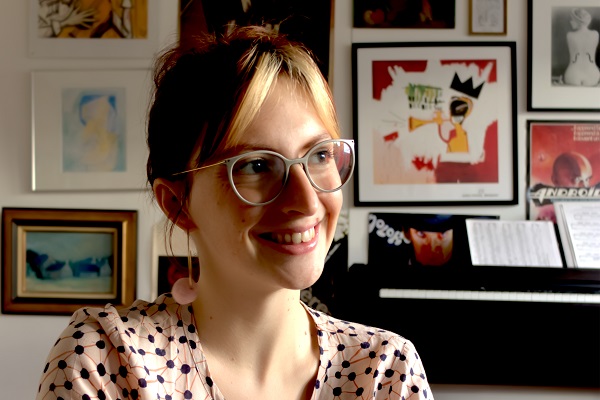 Ruth Lorang, local business owner, designer;
Credit: Ruth Lorang
Ruth Lorang, local business owner, designer;
Credit: Ruth Lorang
Chronicle.lu recently had the opportunity to speak with Ruth Lorang, a Luxembourgish designer, furniture maker and recent local business owner, who is in the process of setting up a multidisciplinary Luxembourg-domiciled design studio.
This one-woman workshop in Luxembourg will serve the objective of creating local, sustainable and socially conscious products, with a focus on furniture and notably "evolutive furniture" for families with young children.
Chronicle.lu: How did you come up with your innovative idea?
Ruth Lorang: The idea to design "evolutive furniture" emerged from my personal experiences and observations of the challenges faced by young parents around me in furnishing their small apartments in a mindful and sustainable way... Finding furniture that is both practical and versatile can be a daunting task. With a growing family, every square metre counts and the furniture needs to adapt to the changing needs of both children and adults... I wanted to break away from the conventional idea of strictly separating children's and adult's furniture, creating a more cohesive family environment. Through my design, I aimed to support the principles of mindful and sustainable living while also enhancing a child's autonomy and responsibility, which are values that I hold dear.
Chronicle.lu: Please describe the process of bringing your idea to fruition.
Ruth Lorang: My design process typically begins with conversing with parents to identify a piece of children's furniture that would be useful to have. Once I have found a piece, I explore creative ways to repurpose it so that it can be used in multiple ways. Before sketching out a design, I conduct research on existing furniture in the field to ensure that I am incorporating all necessary features into the piece. During the design process, I seek feedback from others to ensure that the design is practical and meets the needs of both children and adults. Once the design is finalised, I search for skilled craftsmen to bring it to life. Through conversations with the craftsmen, the design may evolve further. After the first prototype is created, I identify any shortcomings and make necessary improvements for production. This process is not just about designing furniture, but also about building meaningful relationships with parents, craftsmen and everyone involved in bringing the piece to life.
Chronicle.lu: From where do you draw inspiration? What would you say are your main influences?
Ruth Lorang: As a designer, I find that my conversations with people about their furnishing needs and desires often spark my creativity and inspire new ideas for designs. The feedback I receive... helps me understand their lifestyle, habits and preferences, which I can then incorporate into my designs to make them more functional and practical. Furthermore, mid-century design furniture has always fascinated [me] aesthetically speaking but also [for] its focus on functionality.
Chronicle.lu: What materials do you use?
Ruth Lorang: I strive to use natural and eco-friendly materials... For “lana”, I chose a woodpulp board that is PEFC™ certified and free of Optical Brightening Agents and plastics... I selected a 100% organic cotton bag with GOTS certification for packaging. For “fabienne”, I opted for lightweight and recyclable multiplex for the tops, covered with eco-friendly, biodegradable, and recyclable furniture linoleum. The table legs are crafted from steel, ensuring durability and longevity.
Chronicle.lu: How do you ensure sustainability and a long product lifetime?
Ruth Lorang: I ensure sustainability... by using environmentally conscious materials and by locally producing my designs. Additionally, I create evolutive designs, such as “fabienne”, which can adapt to different needs, reduce waste and promote [an eco-friendlier] lifestyle. Through partnering with organisations that provide employment opportunities for people with disabilities, I add a social aspect to my production process. Finally, the collaboration with the well-known carpentry company Parquet Böhm, known for their exceptional woodworking skills, ensures the highest quality and longevity of my products.
Chronicle.lu: Do you take commissions and work with clients to personalise products or design new ones?
Ruth Lorang: Yes, I'm open to taking commissions in a range of design fields, including interior design, scenography, spatial design, furniture design, object design, illustration, graphic design and creating visuals. I love collaborating with clients to create personalised, one-of-a-kind designs that reflect their unique vision and needs. That said, my personal aesthetic and values will always come through in my designs, so clients can expect a cohesive and authentic final product.
Chronicle.lu: You have worked together with Fondation Kräizbierg for the production of your product "lana". What are your plans to ensure your production process will continue being socially responsible?
Ruth Lorang: Collaborating with Fondation Kräizbierg for the production of my product “lana” was a great experience. For “fabienne”, I chose to work with another socially responsible organisation, Ligue HMC... I am eager to explore collaborations with other socially responsible organisations of all kinds. While I cannot guarantee that every product I create will always include a social aspect, I'm committed to fostering an environment that encourages and supports socially responsible practices in my production process.
Chronicle.lu: What are your main objectives going forward, both strategically and specifically?
Ruth Lorang: For the commercial part of ruth.atelier, I hope that “fabienne” and “lana” will be well-received during the launch event on 17 May at Parquet Boehm Showroom and be a strong foundation to bring more products to market and expand my collection, since I already have a number of prototypes and evolutive designs ready to go into production. For the service-based part of the atelier, I aim to attract clients who share my values and appreciate my aesthetic.








